Psyllid Insects Overview
Psyllid insects are a fascinating group of insects with unique characteristics and significant ecological and economic impacts. Their ability to jump, produce honeydew, and vector plant diseases makes them important subjects of study in entomology and agriculture. Understanding their life cycle, behavior, and interactions with plants is crucial for developing effective management strategies to mitigate their impact on crops and natural ecosystems.
Common Names
Psyllids, Jumping Plant Lice
Description
Psylloidea is a superfamily of small, phloem-feeding insects known for their ability to produce large amounts of honeydew. These insects are often referred to as psyllids or jumping plant lice due to their jumping ability and their association with plants.
Adult Characteristics
Appearance
Adult psyllids are small insects that resemble tiny cicadas. However, they can be distinguished by their notably longer antennae, which are composed of 10 segments.
Mobility
Adults are equipped with specialized hind legs that are adapted for jumping, allowing them to move quickly and escape predators.
Feeding
As phloem-feeders, adult psyllids extract sap from plants, which can sometimes lead to plant damage and the production of honeydew, a sugary excretion that can attract other insects like ants and promote the growth of sooty mold.
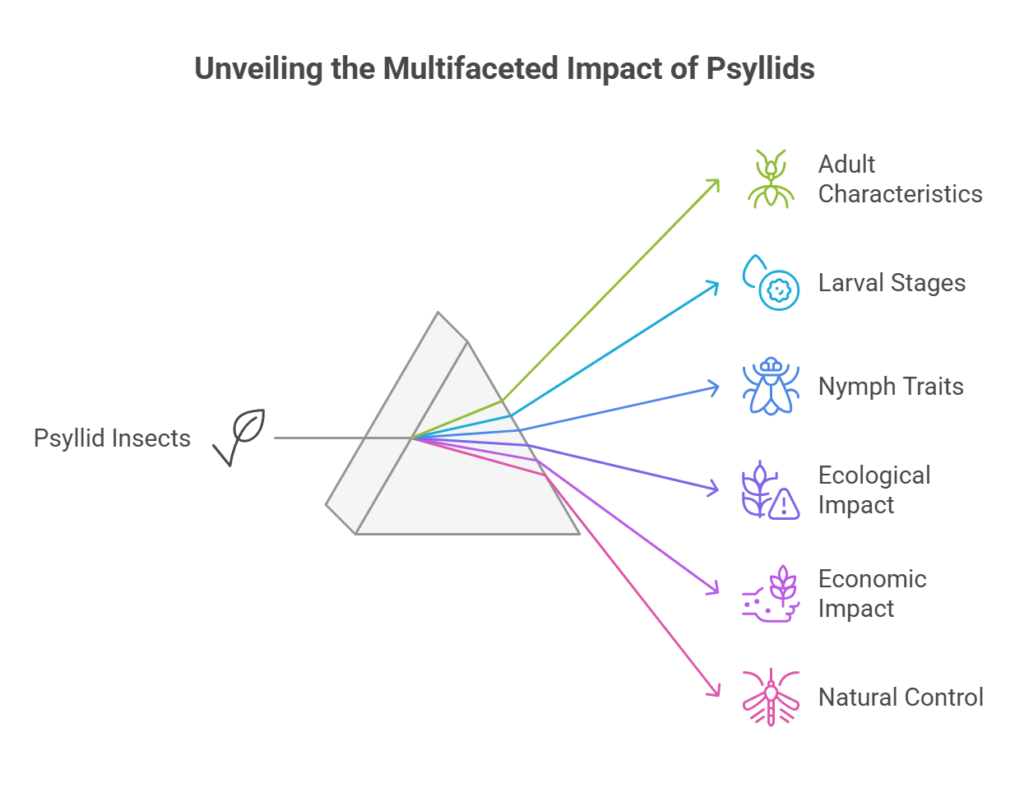
Larval Stages
First Instar
The first larval stage is mobile, allowing the young psyllids to move to suitable feeding sites on the host plant.
Subsequent Instars
The following four larval stages are much less mobile. These larvae are generally sedentary and remain in one place to feed.
Waxy Secretions
Larvae often produce dense waxy secretions, which can provide protection from predators and environmental conditions. These secretions can sometimes be seen as white, fluffy deposits on the plant.
Jumping Ability
Unlike adults, larvae lack the ability to jump.
Nymph Traits
Appearance
Nymphs are flat and scale-like in appearance, which helps them blend in with the plant surface and avoid detection by predators.
Legs
They possess short, grasping legs that are adapted for holding onto plant surfaces and feeding. These legs are not designed for jumping but are well-suited for their developmental needs.
Development
Nymphs undergo several molts as they grow, gradually developing into adults. During these stages, they continue to feed on plant sap, contributing to the overall impact on the host plant.
Ecological Impact
Plant Damage
Psyllids can cause significant damage to plants by feeding on their sap, which can lead to stunted growth, leaf curling, and even plant death in severe cases.
Honeydew Production
The honeydew produced by psyllids can lead to secondary issues such as the growth of sooty mold, which can further harm the plant by blocking sunlight and reducing photosynthesis.
Vector Role
Some psyllid species are known to vector plant pathogens, such as bacteria that cause diseases like citrus greening (Huanglongbing), making them economically important pests in agriculture.
Ecological and Agricultural Significance of Psyllids
Psyllids, members of the superfamily Psylloidea, are small, phloem-feeding insects that play a significant role in both natural ecosystems and agricultural systems. Their ecological interactions, feeding habits, and impact on crops make them a critical subject of study in entomology and agriculture.
Psyllids are ecologically and agriculturally significant insects due to their feeding habits, ability to transmit plant diseases, and impact on crop health and productivity. Their well-developed wings, specialized mouthparts, and interactions with natural enemies highlight their adaptability and the challenges they pose to agriculture. In fruit orchards, particularly apple orchards, psyllid outbreaks can lead to substantial economic losses, underscoring the need for effective management strategies that balance natural control methods with targeted interventions. Understanding the biology and ecology of psyllids is essential for mitigating their impact and ensuring the health of both natural ecosystems and agricultural systems.
Psyllid Biology: Wing Structure, Feeding Habits, and Economic Impact
Wing Structure
i. Description
Psyllids possess well-developed wings, with both the forewings and hindwings being fully functional. This allows them to fly efficiently, aiding in dispersal and finding suitable host plants.
ii. Resting Position
When at rest, psyllids fold their wings in a distinctive roof-like position over their backs. This characteristic wing posture is a key identifying feature of the group.
iii. Adaptation
The ability to fly and jump (due to their specialized hind legs) makes psyllids highly mobile, enabling them to escape predators and colonize new host plants.
Mouthparts (Proboscis)
i. Structure and Function
Psyllids have specialized mouthparts called proboscis, which is adapted for piercing and sucking. This proboscis is used to feed on phloem sap from plants.
ii. Insertion Point
The proboscis is inserted at the base of the prothorax, giving the appearance that it originates behind the foreleg coxae.
iii. Orientation
The proboscis is hypognathous, meaning it is directed downward. This orientation is well-suited for feeding on plant tissues, particularly the phloem, which transports nutrients throughout the plant.
iv. Impact on Plants
Continuous feeding by psyllids can weaken plants, reduce their vigor, and lead to symptoms such as leaf curling, stunted growth, and yellowing.
Economic Impact
i. Phloem Feeding
Psyllids extract large quantities of phloem sap, which can deprive plants of essential nutrients and energy. This feeding behavior is particularly damaging to crops like apples, citrus, and other fruit trees.
ii. Honeydew Production
As psyllids feed, they excrete honeydew, a sugary substance that accumulates on plant surfaces. Honeydew serves as a substrate for the growth of sooty mold, a black fungal growth that can cover leaves and fruit.
- Effects of Sooty Mold: Sooty mold blocks sunlight, reducing photosynthesis and further weakening the plant. It also lowers the aesthetic quality of fruits, making them less marketable.
iii. Economic Losses
Psyllid outbreaks, especially in apple orchards, can lead to significant economic losses due to reduced crop yields, increased management costs, and lower fruit quality.
iv. Disease Transmission
Some psyllid species are vectors of plant pathogens, such as the bacteria responsible for citrus greening (Huanglongbing), which has devastated citrus industries worldwide.
Natural Control
i. Predatory Insects
In many agricultural systems, psyllid populations are naturally regulated by predatory insects such as lady beetles (ladybugs), lacewings, and syrphid flies. These predators feed on psyllid eggs, nymphs, and adults, helping to keep their numbers in check.
ii. Parasitoids
Parasitoid wasps are another important group of natural enemies. They lay their eggs inside psyllid nymphs or adults, and the developing wasp larvae consume the psyllid from within, eventually killing it.
iii. Stable Predator-Prey Dynamics
In perennial crops like orchards, the presence of these natural enemies often creates a stable predator-prey relationship, which helps minimize the agricultural impact of psyllids.
iv. Integrated Pest Management (IPM)
Leveraging natural control mechanisms is a key component of IPM strategies, reducing the reliance on chemical pesticides and promoting sustainable agricultural practices.
Also Read About: Phloem feeding Insects
Life Stages and Habitat of Apple Sucker (Psylla mali)
Apple Suckers (Psylla mali) undergo distinct life stages, each associated with specific habitats.
- Adults: During the growing season, adults primarily inhabit apple trees but may migrate to other tree species as alternate hosts after feeding.
- Eggs: The overwintering stage for this species is the egg, a critical phase for survival and seasonal recurrence.
- Nymphs: Nymphs develop exclusively on young leaves and flowers of apple trees. They pass through multiple stages, feeding on tender apple tissues throughout their development.
Economic Impact
The primary damage caused by Apple Suckers results from their feeding on phloem sap, which deforms young leaves and flowers, reduces fruit set, and promotes the production of honeydew. This honeydew often leads to the growth of sooty mold, further impacting plant health. While economic losses are generally limited, they can become significant during population outbreaks.
Life Cycle
Apple Suckers are univoltine, completing one generation per year. Eggs laid in late summer or fall overwinter and hatch in spring, coinciding with the growth cycle of apple trees. This predictable life cycle simplifies management compared to pests with multiple generations annually.
Management Considerations
Early spring monitoring of egg and nymph populations is essential for predicting potential outbreaks. Natural predators and parasitoids often help control populations. However, during outbreak years, targeted interventions may be required to mitigate economic losses.
Pear Suckers: Feeding Habits, Damage, and Impact on Pear Cultivation
Pear Sucker (Cacopsylla pyri, C. pyrisuga)
The Pear Sucker, comprising species like Cacopsylla pyri and C. pyrisuga, is a significant pest of pear trees. These insects are known for their feeding habits and the damage they inflict on pear cultivation, particularly in regions where they are prevalent.
Feeding Habits
Nymphs of the Pear Sucker primarily feed on the buds, young leaves, and shoots of pear trees. This localized feeding can cause direct damage to the plant tissues, disrupting normal growth and development.
Damage
The feeding activity of Pear Suckers often leads to growth deformities in pear trees. Among the species, C. pyrisuga is particularly notorious for causing severe deformities, which can significantly impact the health and productivity of the trees.
Pest Status
Pear Suckers are considered regionally significant pests, especially in areas where pear tree cultivation is common. Their presence poses considerable challenges for growers, requiring careful management to mitigate their impact.
Spread and Impact
One species, Cacopsylla pyricola, has been introduced to North America, where it has become a notable pest. It acts as a vector for “pear decline,” a disease caused by mycoplasma-like organisms (MLOs). This disease can severely affect pear production, leading to substantial economic losses.
Overwintering
The adult stage of Pear Suckers serves as the overwintering phase. This adaptation allows them to survive harsh conditions during the winter and resume their activity when the growing season begins, ensuring their continued presence and impact on pear trees.
Whiteflies (Aleyrodoidea): Characteristics, Impact, and Management Strategies
Whiteflies, members of the superfamily Aleyrodoidea, are small phloem-feeding insects measuring 1–3 mm in length, notorious for their destructive impact on agriculture, particularly in warm climates. They damage crops by extracting sap, transmitting plant viruses, and promoting sooty mold growth, which reduces plant health and productivity. Managing whiteflies effectively requires an integrated approach, combining biological controls, cultural practices, and chemical interventions, with a strong focus on early detection and targeted action. Understanding their biology and behavior is crucial for developing sustainable solutions to minimize their global agricultural impact.
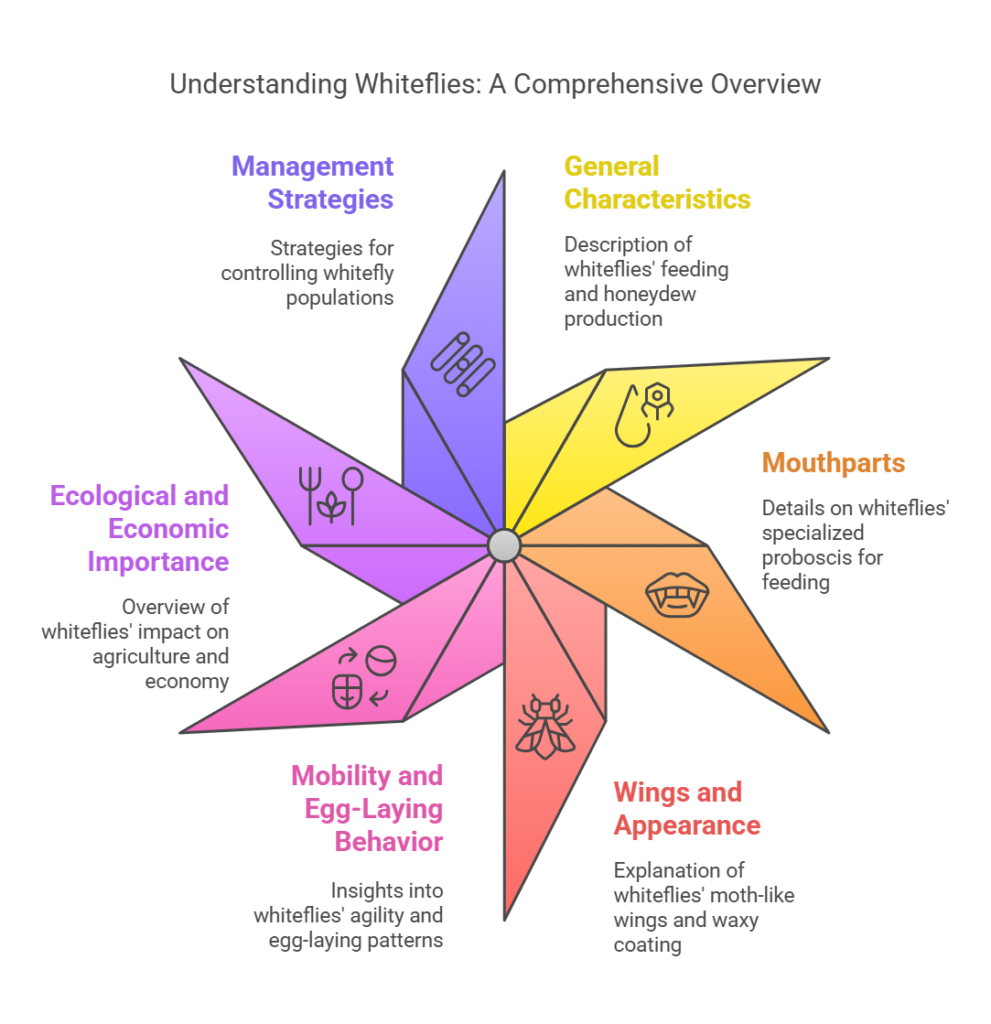
General Characteristics
Whiteflies are small, soft-bodied insects that feed on plant sap by piercing the phloem with their specialized mouthparts. As they feed, they excrete large quantities of honeydew, a sugary substance that accumulates on plant surfaces. This honeydew serves as a substrate for the growth of sooty mold, a black fungal coating that blocks sunlight and reduces photosynthesis. The combination of direct feeding damage and sooty mold growth can severely weaken plants, leading to stunted growth, reduced yields, and even plant death in severe infestations.
Mouthparts (Proboscis)
Whiteflies possess a proboscis, a specialized feeding structure that is freely attached to their head. Unlike some other insects, the proboscis of whiteflies is oriented in a straight, orthognathous position, meaning it points forward. This adaptation allows them to efficiently pierce plant tissues and extract phloem sap. Their feeding behavior not only deprives plants of nutrients but also makes them vectors for various plant pathogens, including viruses.
Wings and Appearance
Whiteflies are easily recognizable by their moth-like appearance. They have two pairs of wings that are relatively large compared to their body size. Both their wings and bodies are covered in a fine, white, waxy powder, which gives them their characteristic name and appearance. This waxy coating serves as a protective layer, helping them resist desiccation and evade predators. The combination of their white color and powdery texture makes them stand out against the green foliage of their host plants.
Mobility and Egg- Laying Behavior
Whiteflies are agile insects, equipped with hind legs that contain jumping muscles. This adaptation allows them to quickly escape when disturbed, making them difficult to control. They are also capable of short flights, which aids in their dispersal to new host plants.
A distinctive feature of whiteflies is their egg-laying behavior. Females lay their eggs in circular or spiral patterns on the underside of leaves. These patterns are often used as a diagnostic feature to identify whitefly infestations. The eggs hatch into nymphs, which go through several developmental stages before becoming adults.
Ecological and Economic Importance
Whiteflies are among the most economically significant pests in agriculture, particularly in warm climates where they thrive. Their impact is twofold:
- Direct Damage: By feeding on phloem sap, whiteflies weaken plants, leading to reduced growth, yellowing of leaves, and lower yields.
- Indirect Damage: They act as vectors for plant viruses, such as the Tomato Yellow Leaf Curl Virus (TYLCV) and Cassava Mosaic Virus, which can devastate crops. Additionally, the honeydew they excrete promotes the growth of sooty mold, further compromising plant health and marketability.
Their ability to rapidly reproduce and adapt to various environments makes them a persistent challenge for farmers worldwide.
Management Strategies
Effective management of whiteflies requires an integrated approach that combines multiple strategies:
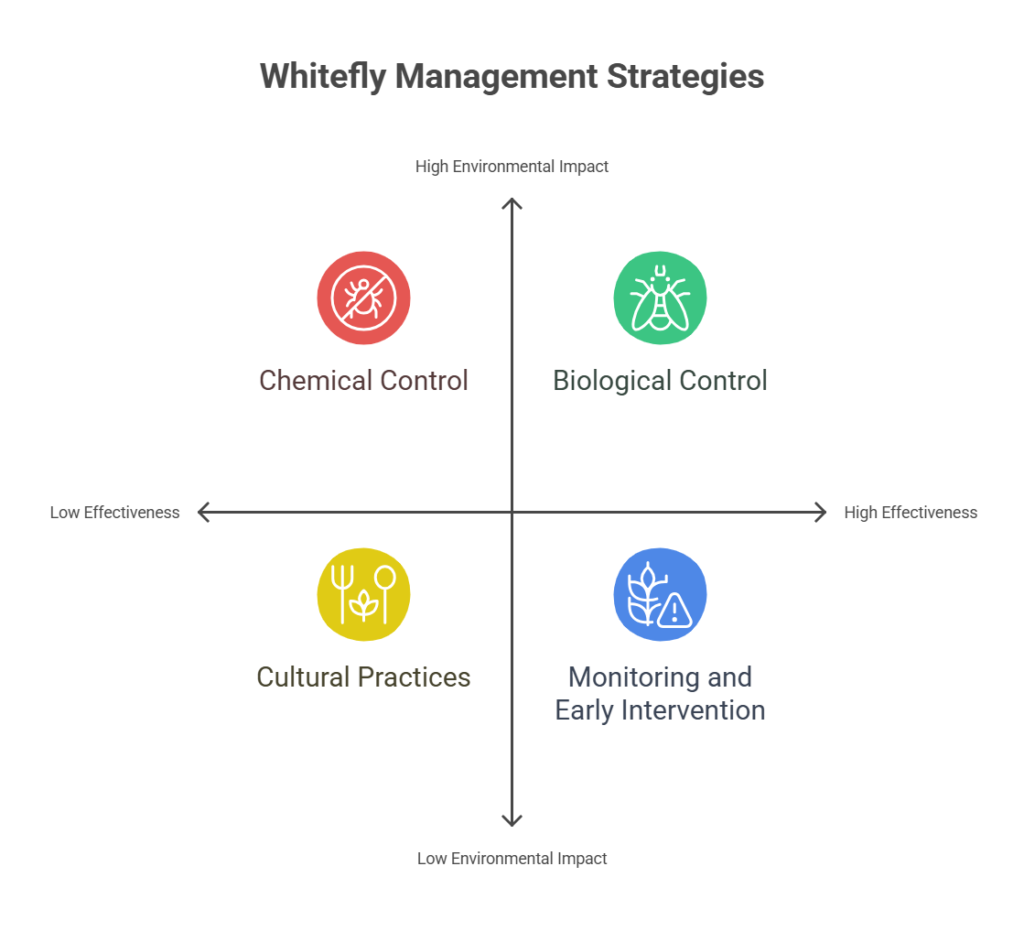
- Biological Control: Natural enemies, such as parasitoid wasps (e.g., Encarsia species) and predatory insects (e.g., lady beetles and lacewings), play a crucial role in regulating whitefly populations. These biological control agents target eggs, nymphs, and adults, helping to keep infestations in check.
- Cultural Practices: Techniques such as crop rotation, removal of infested plant material, and the use of reflective mulches can reduce whitefly populations and limit their spread.
- Chemical Control: Insecticides are sometimes necessary for severe infestations, but their use must be carefully managed to avoid resistance development and harm to beneficial insects.
- Monitoring and Early Intervention: Regular monitoring of crops for eggs and early-stage nymphs is critical, as these are the most vulnerable stages for control. Early detection and intervention can prevent outbreaks and minimize damage.
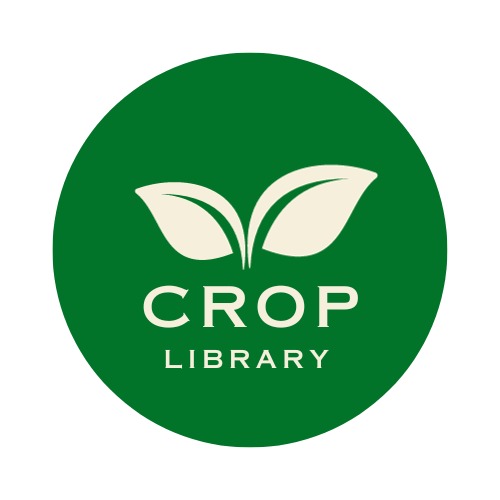
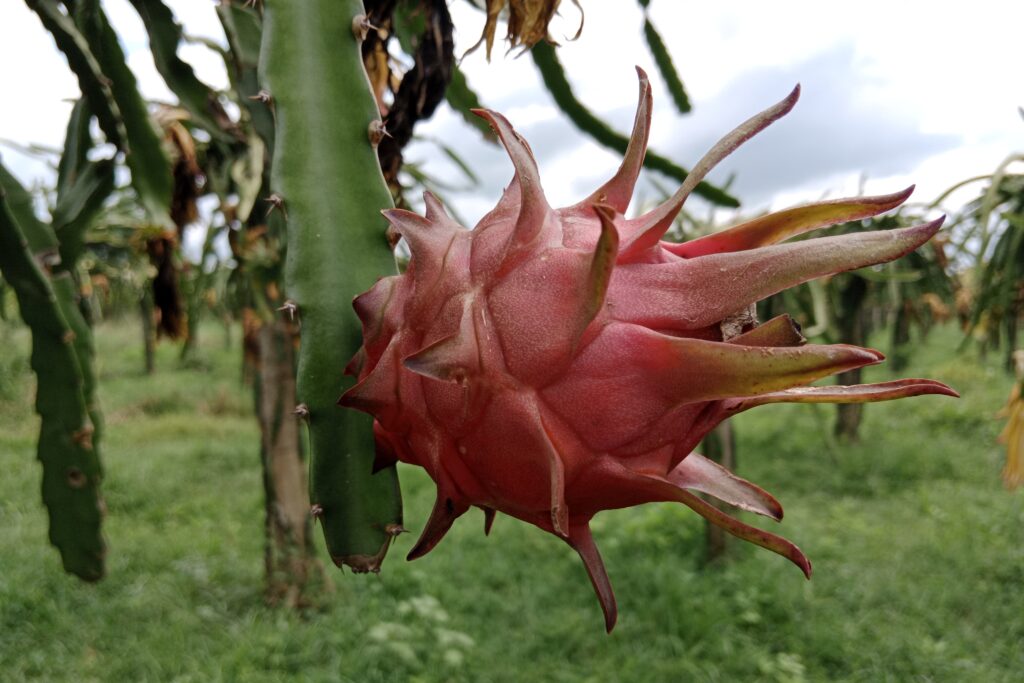
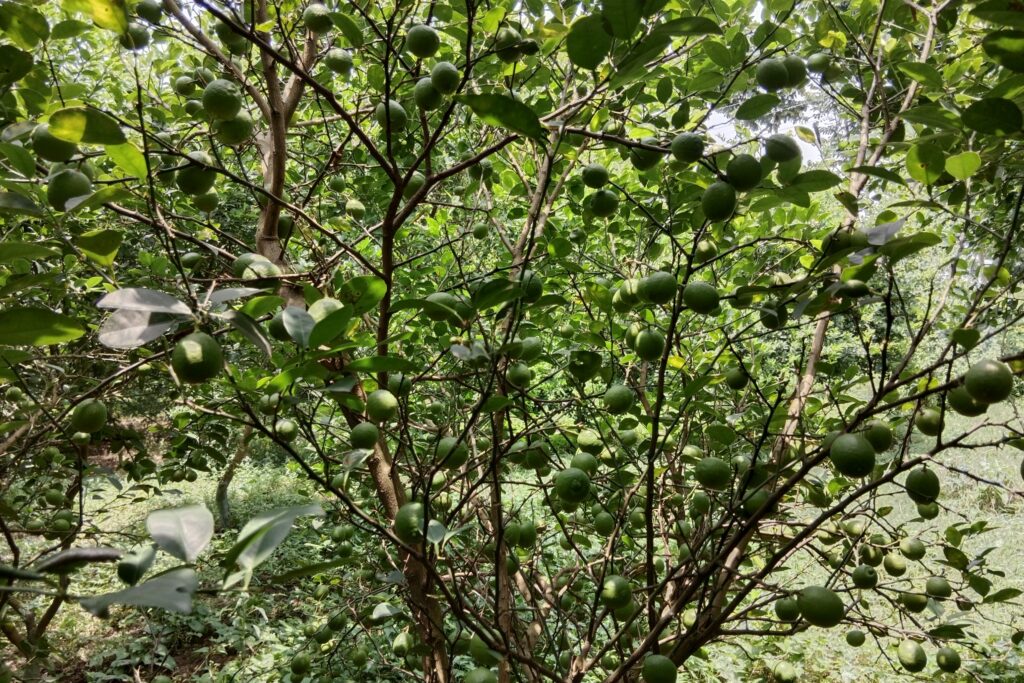
Pingback: Scale Insects: The Tiny Titans of the Plant World -
Pingback: Soft Scales Insect: Exclusive Insights on Key Species and Management Approaches